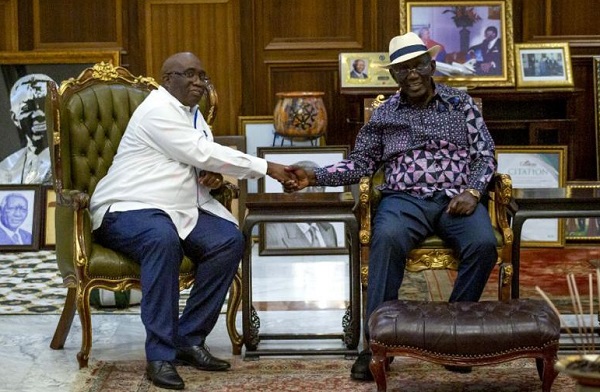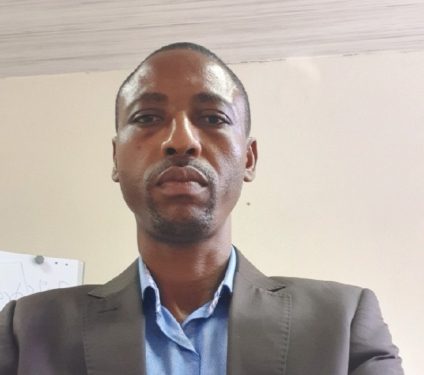This environmental monster would soon lead Ghana to import drinking water

Water is life! Yes, that is a popular adage in Ghana and almost globally, to underscore the essence of water to every living thing. While growing up, we were told that we can deny anyone food for whatever reasons but not water. It was a must to give water to visitors first before you would even ask about their mission. Such is the essence of water.
Ghana is likely to join the list of countries that import water if warnings by the nation’s largest water distribution company, the Ghana Water Company Limited (GWCL) are not heeded to. Aside from GWCL, several studies and news reports have pointed to the fact that the country is losing grips quites fast in the race to preserve the foundation of the country; the natural environment. The company has been vocal in raising concerns about the threats to Ghana’s water treatment and distribution efforts, threats sponsored by illegal mining popularly known as galamsey.

A post published on the company’s website recently revealed the threats to water supply in the Western Region, one of the regions in Ghana notorious for illegal mining. Both Central and Western regions are at the receiving end of the illegal mining mess. And the water company said the levels of sludge in water coming from the two regions has been on the rise, that makes operational cost to also be on the rise as a result.
In the Central Region, six of the seven major raw water sources are feed by water from the Ayensu (2), Pra (1) and Ochi Rivers(3) which are all illegal mining locally known as ‘galamsey’ hotspots. Much activity has not been heard of reported of the Ochi River but the Pra and Ayensu Rivers are sleeping beds for the ‘galamseyers’ (Ghanaian word for illegal miners).

The Western Region as per the Ghana Water Company Limited is still operated as one despite the creation of the Western North from it. The Axim Water Treatment Plant and the Bonsa Headworks, Sekondi Water Supply System and the Daboase Headworks are all served by rivers. River Bonsa, Denkyemzule, Anankwari and Pra serve the four systems. The other four water sources are fed raw water from 26 boreholes. Eight boreholes are also constructed to support the Axim System.

Illegal mining adds a lost of cost into water treatment, a run down that will ultimately raise the pain on the citizens. Stanley Martey, Communications Manager at the GWCL told a gathering Koforidua recently that the company will shut down their plants if the treatment costs goes beyond their reach. “The activities of illegal miners are bringing serious challenges because the chemicals used to treat the water are costly. The tariffs adjustments are not enough. The prices of the chemicals are going up and we need more of the chemicals to treat the water because of the heavy pollution and high turbidity levels,” he complained.
Ghana may not be on the expressway to water importation but with the current trend, it is not allien to think the country has set off on its way to water importation. That would be a shameful thing to do but others may argue that even world heavyweights such as the United States of America, China, Belgium and Russia import water. That would be a lame comparison to make considering that the GDP of those countries dwarfs Ghana. Those countries all have maor products that they export to balance their importation needs. Ghana, however, relies on Cocoa, gold and crude. All these three commodities are exported in raw form, meaning the country gets less for its efforts. So Ghana definitely has no capacity to bear water importation burden.
The consumer is already burdened. Drinking water sold in bottles and sachets has increased in prices twice within this year. The commodity was sold at 20 pesewas for a very long time but in 2022, it increased by 50 per cent and was sold at 30 pesewas from January 27 this year. And just this week, the National Association of Sachet and Packaged Water Producers announced another increment which will see the commodity sold at 50 pesewas effective Monday, September 19, 2022.

The above increment were as a result of increase in production cost resulting from the increase in prices of petroleum products. So if the Ghana Water Company which recently secured a 21.55% tariff increase decides to further adjust is prices by even another 20%, it would take a negative toll on consumers who are already suffering from the havocs of a failed economy. You may ask but why will they increase prices by another 20% just after getting at least 21% increment? That question should not even be asked in the first place. The company in demanding an increase in tariff proposed 334% increment by the Public Utilities Regulatoy Commission beat down the percentage to under 25% which means the company still lags behind by 312.45%. If it was to satisfy its need , it would need at least 300% increase per its last argument made to the PURC, however, with the cost of treatment skyrocketing as a result of illegal mining, it would incur additional cost which would shoot its need percentage higher. Government is not in good standing to subsidize treatment cost so the company would push it on the consumer which would be a burden.
Illegal mining does not only affect the rivers with its pollution but also in the long run will deny the rivers of water. Rain water is the feeding source for all rivers. Illegal mining is done mostly near rivers or in forest reserves where trees are fell to pae way for the exercise. None of the trees is replaced. A 2019 article published by the International Centre for Investivgative Reporting revealed that “More than 12 hectares of the Tano-Offin forest have been destroyed by illegal miners while about 15 hectares of the Atewa forest have reportedly been lost to illegal mining”. The report added that “The Desiri, Kutukrom, Kobro, Oda, Jimira, Atewa, and Tano-Offin forests in the Ahafo, Western, Ashanti, Eastern regions have all suffered from the illegality”. Most rivers get their source from these forest reserves and with the reserves being wiped out, it means the rivers are gradually being starved.

According to a globalforestwatch.org publication, “From 2001 to 2021, Ghana lost 1.41Mha of tree cover, equivalent to a 20% decrease in tree cover since 2000” and “from 2001 to 2021, 5.7% of tree cover loss occurred in areas where the dominant drivers of loss resulted in deforestation”. Unsurprisingly, the two top regions; Western and Ashanti regions produced a total of 58% of the losses. Those two regions are hotspots for illegal mining with the Atewa and Tano-Offin forest reserves home to thousands of illegal miners. The top five regions were Western, Ashanti, Eastern, Central and Brong Ahafo. These areas are the primary locations of illegal mining so it is no coincidence that they account for the top five spots.

With the forest cover fast deteriorating, ran pattern becomes unpredictable as a result of climate change caused by the harm to the environment. Volume of rainfall in Ghana has reduced by 20% since 1960 and is expected to reduced by a further 20.5% until 2085 if the pattern remain. It, however, could outjump the forecast due to the colonization of the countries forests by illegal miners which results in the fast-deterioratig volumes of forest reserve.
All the above pointers trickle down to one thing, water scarcity is not a thing of if but when. When it finally reaches that point and water production in Ghana becomes very expensive, investors would turn their attention to importation and we all know what a nation that is dependent on imported basic goods will go through.
Ghana currently does not import water and majority of its food items are not from either Russia or Ukraine but the ongoing water in Eastern Europe has been blamed for the rising cost of food items so what happens when water is added to the import list?






